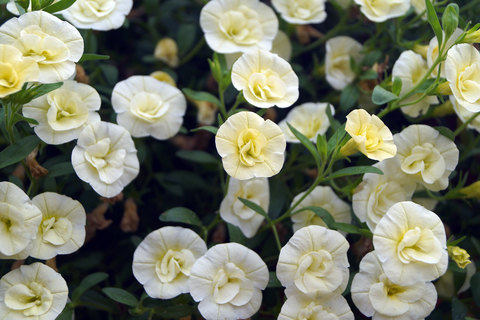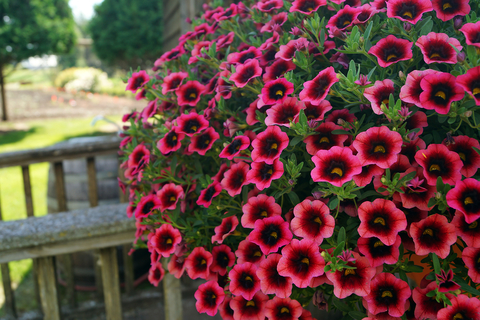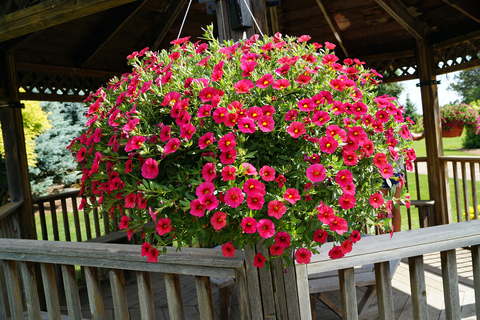Quick facts
- Calibrachoa plants produce little to no seed so plants are propagated from vegetative cuttings.
- They require full sun and are very sensitive to pH levels.
- Calibrachoa produce abundant blooms all season long and have a trailing habit.
- They perform best in hanging baskets or containers rather than in garden beds.
- Common floral colors: Violet, blue, pink, red, magenta, yellow, bronze, white.
Calibrachoa are also called million bells or trailing petunia because of their prolific, bell-shaped flowers and their resemblance to petunias. They are a fairly new ornamental, introduced in the 1990s, and rapidly gained popularity with the gardening world.
This plant is native to South America and typically grows to a height of 6-12 inches and a width of 12-24 inches due to its trailing habit, which makes it suitable for hanging baskets.
Calibrachoa foliage is often sticky to the touch and each plant produces a lot of flowers all season long. Flowers come in a wide variety of colors and often have more than one color to them.
Good performers
Annual calibrachoa are evaluated as part of the U of M flower trials and research. Located at the WCROC in Morris, MN, the Horticulture Display Garden serves as an All-America Selections (AAS) Display Garden and Trail Grounds and provides the public an opportunity to view the newest superior performers.
The following annual calibrachoa cultivars were rated good to excellent in our recent trials in hanging baskets:
- Cabaret Good Night Kiss
- Eyeconic™ Purple
- Bloomtastic Yellow
- SuperBells® series
- Kabloom™ series
- MiniFamous® series
Growing outdoors
Calibrachoa grow best in containers or hanging baskets and should not be planted in garden beds. They can be planted outdoors once soil temperatures are above 55 degrees F.
Requirements for choosing a site for calibrachoa:
- Plants need to have full sun for 8+ hours a day.
- Potting mix must be well-drained with high amounts of organic matter. Try to find a potting mix with multiple sources of organic matter, not just peat moss.
- Calibrachoa prefer soils acidic soils with a pH of 5-6.5. Any higher than this and the plant will not grow as they are very pH sensitive.
Feeding and watering
A general-purpose fertilizer with equal amounts of nitrogen, phosphorus and potassium should be incorporated into the potting mix at time of planting if the mix does not already contain a fertilizer. Since plants produce so many blooms, they are heavy feeders and require lots of fertilizer. Feed the plant a water-soluble fertilizer every other week.
Calibrachoa need frequent watering, especially since they are often in smaller containers and hanging baskets. Watering daily is a good practice. Make sure to keep the potting mix moist but do not overwater to prevent root rot. Make sure the container or basket has functioning drainage holes for excess water.
Diseases are not an issue with calibrachoa but they can be infested by mites and thrips. Insect infestation is rarely at levels to cause harm to the plant.
Other tips for abundant blooms and healthy plants:
- Calibrachoa are self-cleaning and do not require deadheading to promote new flowers.
- Make sure the plant gets good air circulation and allow it to slightly dry out between waterings to prevent insect or disease issues.
- To get a more compact plant rather than a trailing plant, the top 2 inches of the stems can be clipped off at time of planting.
Calibrachoa propagation
Since plants produce little to no seed, they must be propagated by cuttings.
- Choose a stem that doesn’t have any flowers.
- Clip 6 inches off the stem and remove the leaves from the lower half.
- Place the stem in water.
- Roots should begin to develop in 3-4 weeks.
- After roots have grown, the cutting can be placed in a potting mix.
Reviewed in 2021







